
painting, oil-paint
#
portrait
#
tree
#
painting
#
oil-paint
#
landscape
#
house
#
impressionist landscape
#
figuration
#
oil painting
#
group-portraits
#
naive art
#
russian-avant-garde
#
cityscape
#
genre-painting
#
street
#
building
Copyright: Public domain
Editor: Boris Kustodiev’s “Meeting (Easter Day),” painted in 1917 with oil on canvas, presents a vibrant village scene. The composition strikes me as somewhat naive, with its flattened perspective and bold use of color. What compositional elements stand out to you the most in this piece? Curator: I’m particularly drawn to how Kustodiev orchestrates space. Notice the verticality of the church contrasted against the horizontality of the houses. This interplay creates a dynamic tension, amplified by the use of color. The bright blues and greens aren't merely representational; they serve to delineate forms and create visual rhythm. Editor: That's interesting. I was focused on the figures and almost missed how much the architecture contributes to the painting. Can you expand on the use of these specific hues and their impact on depth? Curator: Observe the saturated blue of the house on the right. It's applied almost uniformly, flattening the structure and pushing it forward in the picture plane, despite its spatial placement. Kustodiev prioritizes color and form over realistic representation, leading the eye around the canvas in a deliberate pattern. The placement of color isn't arbitrary, and serves to draw the eye upward towards the focal point. Editor: It's clear how Kustodiev uses color to flatten space and draw the eye. I didn't pick up on that. It feels so carefully planned. Curator: Precisely. Now consider the brushwork. Note how the application of paint contributes to this flattening effect through short, deliberate strokes in areas where realism could prevail. Editor: It seems almost like Kustodiev is creating his own visual language, with its own rules and grammar! Curator: Absolutely! And recognizing those elements is key to deciphering the message of the canvas. It moves us beyond mere recognition to understanding artistic intention. Editor: Thank you for clarifying. I'll definitely view painting in a different way after our chat! Curator: My pleasure. And hopefully, this perspective shift leads to deeper appreciation.
Comments
No comments
Be the first to comment and join the conversation on the ultimate creative platform.













